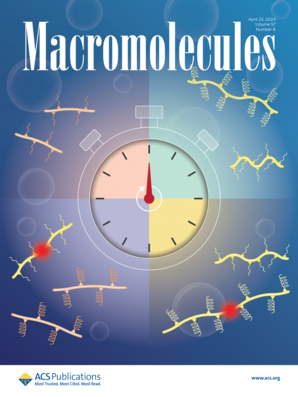具有超高拉伸性能和空前裂纹扩展应变的氢键增强多糖基凝胶
IF 5.2
1区 化学
Q1 POLYMER SCIENCE
引用次数: 0
摘要
现有的方法很难制备出具有优异力学性能和高抗裂纹扩展能力的多糖基凝胶。本文通过将强而致密的氢键整合到网络中,制备了具有超高拉伸性的多糖基聚丙烯酰胺/卡拉胶/植酸(PCP)凝胶。植酸所含的磷酸酯键与聚丙烯酰胺和卡拉胶形成牢固而致密的氢键,比不含植酸的凝胶高18.6倍。大量的氢键使PCP凝胶具有超高的拉伸性能(> 16000%,不破裂),前所未有的16000%的裂纹扩展应变,高粘接性能(223 kPa),自愈能力,耐低温性和保湿性。此外,PCP凝胶可以在几分钟内快速方便地获得,通过简单的绘图方法集成到衣服中,并用于监测运动,呼吸和温度状态(例如手指/手掌的非接触式识别,区分跑步手机/非跑步手机)。该研究为高拉伸凝胶的设计或制造及其在可穿戴电子领域的应用提供了必要的策略。本文章由计算机程序翻译,如有差异,请以英文原文为准。

Hydrogen Bonding Enhanced Polysaccharide-Based Gels with Ultrahigh Stretchability and Unprecedented Crack Propagation Strain
The current strategies prove to be hard for the preparation of polysaccharide-based gels with excellent mechanical properties and high crack propagation resistance. Herein, ultrahigh stretchable polysaccharide-based polyacrylamide/carrageenan/phytic acid (PCP) gels are prepared by integrating strong and dense hydrogen bonds into the network. The phosphate ester bonds contained in phytic acid form strong and dense hydrogen bonds with polyacrylamide and carrageenan, which are 18.6 times higher than those in gel without phytic acid. A large number of hydrogen bonds endows PCP gels with ultrahigh stretchability (>16,000%, without breakage), unprecedented crack propagation strain of 16,000%, high adhesion property (223 kPa), self-healing ability, low-temperature resistance, and moisturizing property. Furthermore, PCP gel can be obtained rapidly and facilely within minutes, integrated into clothes after a facile drawing method, and applied to monitor movement, breathing, and temperature states (e.g., contactless recognition for finger/palm, distinguishing between running phone/nonrunning phone). This study provides an essential strategy for designing or fabricating highly stretchable gel and its application in the wearable electronics field.
求助全文
通过发布文献求助,成功后即可免费获取论文全文。
去求助
来源期刊

Macromolecules
工程技术-高分子科学
CiteScore
9.30
自引率
16.40%
发文量
942
审稿时长
2 months
期刊介绍:
Macromolecules publishes original, fundamental, and impactful research on all aspects of polymer science. Topics of interest include synthesis (e.g., controlled polymerizations, polymerization catalysis, post polymerization modification, new monomer structures and polymer architectures, and polymerization mechanisms/kinetics analysis); phase behavior, thermodynamics, dynamic, and ordering/disordering phenomena (e.g., self-assembly, gelation, crystallization, solution/melt/solid-state characteristics); structure and properties (e.g., mechanical and rheological properties, surface/interfacial characteristics, electronic and transport properties); new state of the art characterization (e.g., spectroscopy, scattering, microscopy, rheology), simulation (e.g., Monte Carlo, molecular dynamics, multi-scale/coarse-grained modeling), and theoretical methods. Renewable/sustainable polymers, polymer networks, responsive polymers, electro-, magneto- and opto-active macromolecules, inorganic polymers, charge-transporting polymers (ion-containing, semiconducting, and conducting), nanostructured polymers, and polymer composites are also of interest. Typical papers published in Macromolecules showcase important and innovative concepts, experimental methods/observations, and theoretical/computational approaches that demonstrate a fundamental advance in the understanding of polymers.
 求助内容:
求助内容: 应助结果提醒方式:
应助结果提醒方式:


